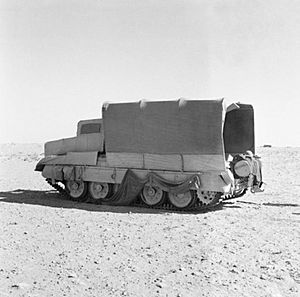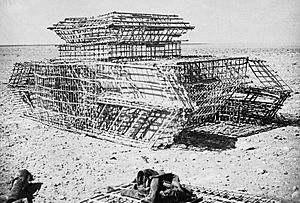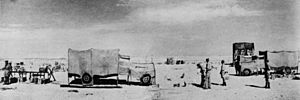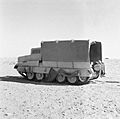Middle East Command Camouflage Directorate facts for kids
Quick facts for kids Middle East Command Camouflage Directorate |
|
|---|---|

A Crusader tank in Operation Bertram
masquerading as a truck in its 'Sunshield' |
|
| Active | 1941–1943 |
| Country | United Kingdom |
| Branch | Royal Engineers |
| Role | Military camouflage training & operations |
| Garrison/HQ | Helwan, Egypt |
| Nickname(s) | Camouflage |
| Engagements | Siege of Tobruk El Alamein |
| Commanders | |
| Notable commanders |
Geoffrey Barkas |
The British Middle East Command Camouflage Directorate was a special team during World War II. They were also called the Camouflage Unit or Camouflage Branch. Their main job was to create clever tricks to fool the enemy. These tricks were part of big deception operations in the Western Desert Campaign.
This unit helped the British army win important battles. They used camouflage during the siege of Tobruk. They also built a fake railway station at Misheifa. Their biggest trick was Operation Bertram for the important Second Battle of El Alamein in October 1942. Even Winston Churchill, the British Prime Minister, praised their success.
These tricks helped win the war by making the enemy look in the wrong places. They wasted enemy bombs and saved important things like the water plant at Tobruk. They also made the enemy think the British army was stronger or weaker than it was. Operation Bertram might have been the last big physical deception in war. Later deceptions, like for D-Day, used more electronic tricks.
The unit was led by Geoffrey Barkas, who was a film director. His team included many talented artists. These artists became camouflage officers, sometimes called "camoufleurs". One key member was the artist Steven Sykes. He was the first camouflage officer of his kind in the British army.
Contents
Who Led the Camouflage Team?
Meet Geoffrey Barkas, the Director
Geoffrey Barkas (1896–1979) was the leader of the Camouflage Directorate. He was a brave soldier in World War I, fighting in the Gallipoli campaign and the Battle of the Somme. He even won a special medal called the Military Cross.
Before World War II, Barkas made movies. He was a writer, producer, and director. In 1937, he joined a company called Shell-Mex/BP. His boss there, Jack Beddington, helped him get into military camouflage. In May 1940, Barkas quickly joined the Royal Engineers. He had a short 10-day training course. Then he took a camouflage course. He practiced his ideas in Northern Ireland in 1940. He taught others, showed demonstrations, and wrote a guide.
How the Camouflage Unit Started
Early Days in Egypt
At the end of 1940, Barkas and his artists went to Egypt. He arrived on a ship called Andes on January 1, 1941. He flew over the desert to see how it looked from above. He noticed patterns like "Wadi" and "Polka Dot." He hoped to use these patterns for camouflage.
To get his new unit noticed, he printed a special booklet. It was called "Concealment in the Field." It was clear and easy to read. The British Army's Middle East Command quickly saw how important it was. They made it a must-have for every army unit. Barkas was promoted to Director of Camouflage. He became a lieutenant colonel.
On September 19, 1941, Steven Sykes became the first camouflage officer in the Eighth Army. He was promoted to Major. From early 1942, Peter Proud helped with training and new ideas.
Training for Camouflage Experts
A special training center was set up in Helwan, Egypt. It was called the Camouflage Development & Training Centre (CDTC.ME). This happened in November 1941. The main leader was Major John Sholto Douglas. A famous zoologist, Hugh Cott, was the Chief Instructor. Cott was an expert in how animals use camouflage.
The center worked closely with the soldiers fighting in the desert. They made sure their training was always up-to-date. The center also had a workshop. They created many new ideas for fake vehicles, tanks, and planes. They also made other things that looked like signs of battle. Every new trick was tested from the air. The Royal Air Force helped with these tests.
Amazing Deception Operations
Fake Railway for Operation Crusader
One of the first big tricks was a fake railway at Misheifa. Barkas asked the artist Steven Sykes to build it. The goal was to make the enemy bomb the fake railway instead of the real one. The real railway at Capuzzo was bringing important supplies for Operation Crusader.
This trick was very detailed. It included about 6 miles (10 km) of fake railway tracks. There was a fake train and fake sidings. They also made many dummy tanks. Everything was built from simple materials like palm tree branches. It all looked like real supplies delivered by the railway.
The enemy dropped over 100 bombs on the fake Misheifa railway. This cut the attacks on the real railway at Capuzzo by half. Barkas joked that "camouflage men must be among the few otherwise sane beings who yearn to be bombed." This first big trick was a success. They did it in just a few weeks, even with very few men and materials.
The writer Julian Trevelyan saw the fake railway. He wrote:
The dummy railhead looks very spectacular in the evening light. No living man is there; but dummy men are grubbing in dummy swill-troughs, and dummy lorries are unloading dummy tanks, while a dummy engine puffs dummy smoke into the eyes of the enemy.
—Julian Trevelyan
Camouflage Tricks at Tobruk Siege
During the war, the British army had to retreat. The camouflage officer Peter Proud and Sergeant William Murray Dixon got stuck in the city of Tobruk. Proud quickly started a camouflage unit there. He got help from Australian engineers and Indian laborers.
Materials were hard to find during the siege. Proud used whatever he could. He used old wood and fabric to make camouflage nets. He even used food! Camouflage paint was made by mixing old flour with spoiled Worcester sauce. Barkas said it was "a revolting but highly adhesive paste."
Proud put up a sign for a "Camouflage Service Station." He offered to camouflage army vehicles while drivers waited. This was a trick itself. It created many vehicle tracks in areas away from real targets. This made enemy spy planes think that fake army bases were very busy.
Proud also protected three key places in Tobruk: the harbor, a small air base, and the water plant.
Protecting the Harbor and Airfield
The harbor in Tobruk was bombed a lot by the Luftwaffe (the German air force). Many sunken ships made it hard to use. Proud and Murray Dixon built fake docks and fake sunken boats. Under these, they hid small but important gunboats and transport ships. The Royal Navy thanked Proud for his help.
For the Royal Air Force, Proud had caves dug to hide two Hurricane fighter planes. The third plane was hidden in a hole next to the runway. It was shaped like the plane and covered with a lid and tents. They also built fake planes and hangars to draw enemy fire. These fake targets were even marked as real on enemy air photos. All the real planes survived the siege. This was important for defense and for keeping the soldiers' spirits up.
Saving the Water Plant
The desalination plant made drinking water for Tobruk. It was impossible to hide. The enemy knew exactly where it was. So, Proud and Murray Dixon made the plant look like it had been destroyed.
They painted a fake black hole on the roof and side of the building. They added fake shrapnel marks. They tore down an old chimney. They brought in real rubble, empty oil drums, and wrecked vehicles. They also made fake bomb craters. The final touch was real smoke from burning oily rags. After this, the plant was never attacked again.
Big Deception for El Alamein
Barkas's camouflage unit helped Montgomery win the Second Battle of El Alamein. They used a huge deception called Operation Bertram. It ran from August 1942 until the battle in October.
As part of the plan, 600 tanks were disguised as supply trucks in the north. At the same time, fake tanks, fake supplies, and a whole fake water pipeline were set up in the south. The trick worked! Rommel's staff believed the attack would come from the south. So, they moved many of their forces there.
Barkas called Operation Bertram:
the task of providing props for the biggest 'film production' on which I ever expect to be engaged
—Geoffrey Barkas
Winston Churchill praised Operation Bertram in November 1942. He said:
By a marvellous system of camouflage, complete tactical surprise was achieved in the desert. The Xth Corps, which he had seen from the air exercising fifty miles in the rear, moved silently away in the night, but leaving an exact simulacrum of its tanks where it had been, and proceeded to its points of attack.
—Winston Churchill, 1942
Clever Tricks and Inventions
The camouflage unit invented or improved many techniques and devices. They used these to fool the enemy.
| Trick Type | Device Name | How it was Made | Where it was Used |
|---|---|---|---|
| Disguise (tank as truck) | "Sunshield" | A cover that looked like a truck | Operation Bertram |
| Disguise (gun as truck) | "Cannibal" | A cover with ropes to hold it up | Operation Bertram |
| Disguise (supplies as truck or tent) | Net-covered stack | Real supplies covered with canvas and nets | Operation Bertram |
| Disguise, Fake Damage | False bomb damage, with smoke | Painted fake holes, burning oily rags | Siege of Tobruk water plant |
| Fake Display | "Net Gun Pit" | Netting and canvas with poles | Operation Sentinel |
| Fake Display | False armored division | Fake tanks, fake wrecked vehicles | Operation Bertram |
| Fake Display | Dummy railhead | Wooden poles, petrol cans, canvas, wrecked items | Operation Crusader |
| Fake Display | Dummy port | Wood, canvas, paint, rafts | Operation Crusader |
| Fake Display | Dummy pipeline | Petrol cans, canvas, found materials | Operation Bertram |
Key People in the Camouflage Team
The camouflage team was mostly made up of artists. Many were already famous before the war. Hugh Cott was different. He was a zoologist and an expert in animal camouflage. His book, Adaptive Coloration in Animals, was even carried by army officers for advice.
| Name | Job Before the War | Role in Camouflage Unit | What They Did |
|---|---|---|---|
| Barkas, Geoffrey | Filmmaker | Director of Camouflage | Started the unit, created the camouflage school, hired officers |
| Sykes, Steven | Stained glass artist, potter | Second in command | Built the fake railway; helped with Operation Crusader camouflage |
| Ayrton, Tony | Painter | Second in command (after Sykes) | Helped with Operation Bertram |
| Robb, Brian | Painter, illustrator | Camouflage officer | Helped with Operation Bertram |
| Proud, Peter | Film art director | Camouflage officer | Led camouflage and tricks in the Siege of Tobruk; created "Net Gun Pit" |
| Dixon, William Murray | Sergeant | Camouflage officer | Helped with Siege of Tobruk camouflage and tricks |
| Cott, Hugh B. | Zoologist | Chief Instructor | Taught camouflage courses |
| Douglas, John Sholto | Major, Royal Scots Guards | Commandant, School of Camouflage | Ran the camouflage training school |
| Galligan, Edwin C. | Commercial artist | Camouflage officer | Helped in the Siege of Tobruk |
| Maskelyne, Jasper | Stage magician | Head of "Camouflage Experimental Unit" | Developed early "Sunshield" ideas |
| Copnall, Edward Bainbridge | Sculptor | Camouflage officer | Helped with Operation Crusader |
| Medley, Robert | Painter | Camouflage officer | Helped with Operation Crusader |
| Codner, John | Painter | Camouflage officer | Helped with Operation Crusader |
| Pusey, Fred | Film art director | Camouflage officer | Helped with Operation Crusader |
| Baker, John H. | Architect | Camouflage officer | Helped with Operation Crusader |
The End of Big Physical Deceptions
Operation Bertram was likely the last very large physical deception in war. After that, most big tricks, like those for the Operation Overlord "D-Day" landings, used more electronic methods. They still had some physical parts, like the fake oil storage facility at Dover. But today, with spy satellites and constant electronic tracking, it's much harder to fool an entire army with physical tricks.
Images for kids





